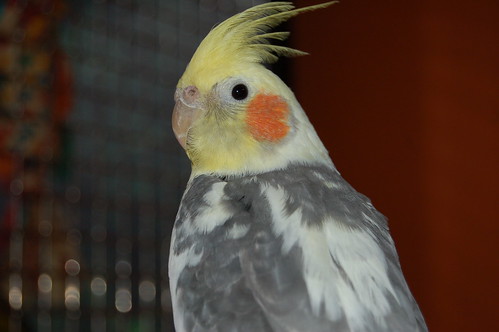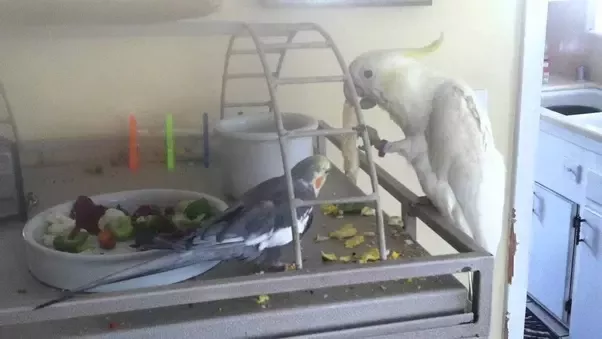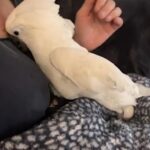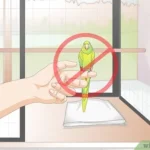Cockatoos can socialize with other birds but require careful introduction and monitoring. Compatibility varies by individual temperament and species.
Navigating the dynamic world of bird socialization, cockatoos often emerge as charismatic yet complex pets capable of forming bonds with other feathered companions. Owners must understand that while some cockatoos might relish the company of other birds, the interaction is fraught with potential challenges.
These sociable parrots possess distinct personalities and a strong need for social interaction, which can either lead to harmonious aviary relationships or spark territorial disputes. To ensure a peaceful coexistence, it is crucial for owners to assess the behavior of their cockatoos, provide adequate space, and conduct supervised introductions. Emphasizing the right match in terms of species and personalities can help foster a friendly environment among avian housemates.

Credit: www.quora.com
Social Dynamics Of Cockatoos
Cockatoos are more than just pretty birds. Their social interactions are complex and fascinating. Pet owners and bird enthusiasts often ponder whether these vibrant creatures can coexist peacefully with other feathered friends.
Cockatoo Personality Traits
Cockatoos are notable for their vibrant personalities. They enjoy strong bonds with their humans and bird companions alike. Here are a few traits that stand out:
- Bold and Curious: They’re not afraid to explore their surroundings merrily.
- Affectionate: They seek and offer attention, craving social interaction.
- Intelligent: Their smarts mean they require stimulation to stay happy.
- Vocal: Their calls and sounds mark a means of communication.
Natural Flocking Behavior
In the wild, cockatoos are gregarious and thrive in flocks. This behavior extends to life in captivity. A table highlighting their social needs follows:
| Behavior | Explanation | Impact on Co-habitation |
|---|---|---|
| Community-oriented | Prefers to be part of a group | May get along with other birds if introduced properly |
| Protective | Defends their mates and territory | Potential issues with new birds entering their space |
| Hierarchy-aware | Understands rank within groups | Necessary to establish pecking order when mixed with others |
| Playfulness | Enjoys social games and activities | Positive interaction possible with playful species |
Whether cockatoos will be friendly with other birds often depends on the individual bird’s temperament, past experiences, and the species they’re introduced to. Owners should observe their pet’s behavior and consult with avian experts for the best pairing practices.
Inter-species Avian Relationships
Inter-Species Avian Relationships can be as complex and varied as human friendships. In the bird world, not all species flock together. Cockatoos, with their sociable and affectionate nature, often captivate bird lovers with their ability to form bonds. Yet, it’s vital to understand the nuances before introducing a cockatoo to other feathered friends.
Factors Affecting Bird Companionship
The harmony among birds hinges on several factors:
- Personality – Individual temperaments can lead to either fast friends or feathery foes.
- Size – Birds of similar size may get along better, reducing the risk of injury.
- Species – Some species naturally gel while others might clash.
- Space – Ample space can promote peaceful cohabitation, while cramped conditions might breed conflict.
- Environment – A stimulating environment with plenty of toys can reduce inter-bird tension.
Typical Bird Pairings In Aviculture
Experts in aviculture have noted certain pairings that tend to succeed more often. See this table:
| Bird Type | Compatible With | Notes |
|---|---|---|
| Cockatoos | Other Cockatoos | Same species pairings typically safest |
| Small Parrots | Budgerigars, Lovebirds | Similar sizes and social needs |
| Large Parrots | Macaws, Amazons | Roomy environments necessary |
Matching a cockatoo with another bird requires careful consideration to ensure compatibility. Trust in the shared space and resource access shapes success in these feathery pairings.
Potential Cockatoo Cage Mates
Potential Cockatoo Cage Mates sheds light on the feathered friends your cockatoo can share its space with. Cockatoos are social creatures, but not all birds make suitable roommates for them. It’s crucial to choose a compatible companion to ensure a harmonious habitat. Let’s look at potential cage mates that can coexist peacefully with your cockatoo.
Compatible Bird Species For Cockatoos
Selecting the right bird friend for your cockatoo requires careful consideration. The best companions are often those with similar size and temperaments. Here’s a list:
- Other Cockatoos: Varieties such as Galahs or Corellas could be a match.
- Large Parrots: Like Amazons or African Greys, which are also sociable.
- Macaws: Bold in character, they can hold their own with cockatoos.
Note that introductions should be gradual and supervised. Even compatible species can have individual differences.
Species To Avoid
Not all birds can live with cockatoos. Avoid these species:
| Species | Reason to Avoid |
|---|---|
| Small birds | Size difference can lead to accidental injury or bullying. |
| Birds of prey | Natural instincts can trigger aggressive behavior. |
| Very territorial birds | They can cause constant conflict and stress. |
Always prioritize your cockatoo’s safety and well-being when considering a new cage mate.

Credit: birdtricksstore.com
Cockatoos In Multi-bird Households
Introducing feathery friends to a multi-bird household can be challenging. Cockatoos, known for their sociable and affectionate nature, may seem perfect for such environments. Yet, their complex personalities require careful consideration. Let’s dive into how cockatoos can adapt to living alongside other birds.
Managing A Peaceful Aviary
To foster harmony in a bird community, structure is key. Adequate space allows each bird to have its own sanctuary.
- Separate feeding areas prevent competition over food.
- Multiple perches and toys reduce rivalry.
- Constant monitoring helps catch early signs of discord.
It’s not just about physical space – the emotional climate is vital too. Birds should feel secure and stress-free. Include hiding spots for privacy.
Interact with each bird daily. Bonding time should be separate to not ignite jealousy.
Preventing Territorial Aggression
Cockatoos may become bossy. Keep an eye on body language and vocal signals to prevent clashes.
| Signal | Meaning | Action |
|---|---|---|
| Ruffled feathers | Show of dominance | Divert attention |
| Squawks | Warning sign | Check for stressors |
| Lunging motion | Aggression | Separate birds |
Introduce new birds slowly. Start with visual contact through separate cages. Move to brief, supervised interactions only if calm prevails.
Never force a relationship. Observe carefully and respect each bird’s need for space.
In conclusion, remember: peace within an aviary is a delicate balance. Allow cockatoos to socialize, but be vigilant and ready to foster calm at any sign of trouble. The result will be a tranquil, joyful environment for all your winged companions.
Introducing Cockatoos To Other Birds
Do you have a cockatoo and are considering another feathered friend? It’s important to introduce cockatoos to other birds carefully. With their strong personalities, cockatoos can be both loving and territorial. A proper introduction can help ensure a harmonious flock.
Step-by-step Introduction Process
A successful introduction of cockatoos to other birds requires patience and careful steps. Follow these guidelines:
- Initial Observation: Keep the new bird in a separate cage. Allow both birds to observe each other from a distance.
- Gradual Approach: Gradually move the cages closer over several days, monitoring their reactions.
- Neutral Territory: Introduce both birds in a neutral space neither considers their own.
- Supervised Interaction: Allow them to interact under supervision. Look for signs of aggression or fear.
- Separate If Needed: If tensions rise, separate the birds and try again later. Patience is key.
- Shared Space: Once they show calm behavior around each other, allow them to share a space for short periods.
- Increase Shared Time: Gradually increase the time they spend together as long as they remain calm.
Monitoring Interactions
Always watch the birds when they’re together. Look out for these behaviors to keep the peace:
| Positive Signs | Warning Signs |
|---|---|
| Curiosity | Aggression |
| Mimicking | Feather Plucking |
| Sharing Toys | Screeching |
Separation may be permanent if cockatoos show consistent aggression. This will prevent harm to both birds.
The Impact Of Captivity On Bird Behavior
Keeping cockatoos alongside other birds can be challenging. In captivity, these intelligent and social creatures face various stresses that can alter their behavior. Understanding these changes is key to creating a peaceful multi-bird environment.
Effects Of Confinement
Captivity often limits natural behaviors, leading to frustration and aggression in birds. Sudden changes in a cockatoo’s behavior may signal distress. Overcrowding can worsen these effects. To mitigate this:
- Provide ample space for flight and exercise.
- Ensure private rest areas for each bird.
- Monitor interactions closely, especially early on.
Enrichment For Harmonious Living
Enrichment is crucial for a healthy captive life. It helps reduce boredom and encourages natural behaviors. For harmony among different bird species, consider:
- Various toys to cater to different species’ needs.
- Puzzle feeders to keep their minds active.
- Regular changes in the environment to stimulate exploration.
Customized care and enrichment lead to happier, more sociable birds.
Risks Of Multi-bird Environments
Risks of Multi-Bird Environments present a unique challenge for cockatoo owners. While these intelligent birds may enjoy social interactions, housing them with other birds can lead to unforeseen complications. Understanding the potential risks is crucial for a harmonious and healthy avian household.
Disease Transmission
In multi-bird environments, the spread of illness is a significant concern. Birds, including cockatoos, can easily contract diseases from one another, especially in close quarters. It is important to monitor for symptoms and maintain regular veterinary check-ups.
- Psittacosis (also known as parrot fever) can spread through the air.
- Polyomavirus affects young birds and can be deadly.
- Beak and feather disease is contagious and incurable.
Separate new birds for at least 30 days before introducing them to established pets. Always wash hands and disinfect supplies when handling multiple birds.
Signs Of Stress And Conflict
Mixed-species interactions can cause stress, leading to conflict and aggression. Observing your birds’ behaviors is key to preventing altercations.
| Sign of Stress | Description |
|---|---|
| Feather Plucking | A sign that a bird is anxious or bored. |
| Screaming | Louder and more frequent vocalizations can indicate distress. |
| Aggression | Change in behavior towards birds or humans. |
| Lethargy | Lack of energy or movement may be a subtle hint of stress. |
Always provide adequate space and enrichment to alleviate tension. Introduce birds to each other slowly and in a controlled environment to gauge compatibility. Watch for these signs regularly to ensure the well-being of your feathered friends.

Credit: www.npr.org
Success Stories And Cautionary Tales
Are you curious whether cockatoos can befriend other birds? Discover heartwarming success stories and heed the lessons from less ideal encounters. Each tells a story of personality, compatibility, and environment at play.
Harmonious Cockatoo Pairs
Many cockatoo owners beam with pride as they share tales of their birds living in harmony. These success stories highlight certain conditions that can lead to peaceful cohabitation.
- Proper Introduction: Gradual introduction ensures a smoother transition and fosters acceptance.
- Space Matters: Spacious cages reduce competition and stress between birds.
- Personality Matching: Complementary tempers can result in lasting avian friendships.
- Watchful Monitoring: Close supervision, especially early on, prevents possible conflicts.
Consider the story of a sulfur-crested cockatoo forming an unlikely bond with a macaw after shared playtime. Their owners attribute success to consistent supervision and separate sleeping quarters.
Lessons From Failed Introductions
Not all interactions between cockatoos and different bird species are positive. Some attempted introductions serve as cautionary tales for avian enthusiasts.
- Personality Clashes: Conflicting behaviors can lead to aggression and injury.
- Resource Guarding: Sharing food and toys does not come naturally to all birds, causing strife.
- Size Disparity: Smaller birds may be intimidated or harmed by larger cockatoos.
- Stress Signals: Ignored signs of distress can escalate to harmful situations.
An example includes a cockatoo and a parakeet experiencing stress and fearfulness due to mismatched sizes and energy levels. The birds required separation for their well-being.
Knowing cockatoos’ social instincts and the importance of a controlled environment is crucial. Consider each bird’s needs and observe interactions closely for the best outcomes.
Conclusion
Cockatoos can be sociable with other birds, but it’s case-specific. Personality and species interactions are key. Safeguarding their well-being means close monitoring of their social encounters. Remember, every bird’s experience is unique. Embrace patience and attentiveness to ensure a harmonious aviary community.
Ryan Everhart is a passionate bird enthusiast and blogger, primarily writing on his website, Avian Whispers. His journey into the world of bird blogging began with a deep interest in parrots, a species that captivated his attention for their intelligence and social behavior. Over time, his content expanded to cover a broader range of bird species, offering insights into bird behavior, care, habitats, and conservation.
Ryan is dedicated to educating his audience, which includes both new bird owners and seasoned enthusiasts. His writing is filled with personal experiences, expert knowledge, and practical advice on bird care. Through Avian Whispers, he aims to foster a deeper appreciation for birds, emphasizing their role in nature and the joys of having them as pets.
Starting with articles focused on parrots, Ryan’s work now encompasses a diverse range of topics such as feeding, training, habitat enrichment, and bird health. His love for birds extends beyond parrots, diving into various avian species. His informative and heartfelt writing reflects his commitment to the well-being of birds and the desire to help others connect with these creatures.
As a growing voice in the bird blogging community, Ryan strives to provide a platform where bird lovers can learn, share experiences, and connect over a shared passion for avian life. His blogs are not only educational but also serve as a reminder of the importance of protecting and nurturing the bond between humans and birds.




